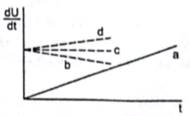A constant current i is passed through a resistor. Taking the temperature coefficient of resistance into account, indicate which of the plots shown in figure base represents the rate of production of thermal energy in the resistor.

When current passes through a resistor, the heat produced by Joule’s heating effect is given by-
![]()
where,
I = current
R = resistance of the resistor
t = time for which current is flowing
Since with increase in the temperature of the resistor, its
resistance is also increased.
The rate of production of thermal energy ![]() in the resistor will be-
in the resistor will be-
![]()
![]() where
where
i = current flowing through the resistor and
R = resistance of the resistor
From above equation, the rate of production of thermal energy in
the resistor is directly proportional to the resistance.
Since, due to the heat generated by the resistance the operating temperature of the resistance increases given by the formula below:
R=Ro(1+αT)
Where
Ro is the initial resistance of the resistor
α is the coefficient of thermal conductivity
T is the temperature
Thus, the resistance of the resistor start increasing with the increase in temperature.
From the graph,
![]() also increases linearly with time starting from a point
also increases linearly with time starting from a point ![]() , which is best shown by plot d.
, which is best shown by plot d.
Thus, option D is the correct option.